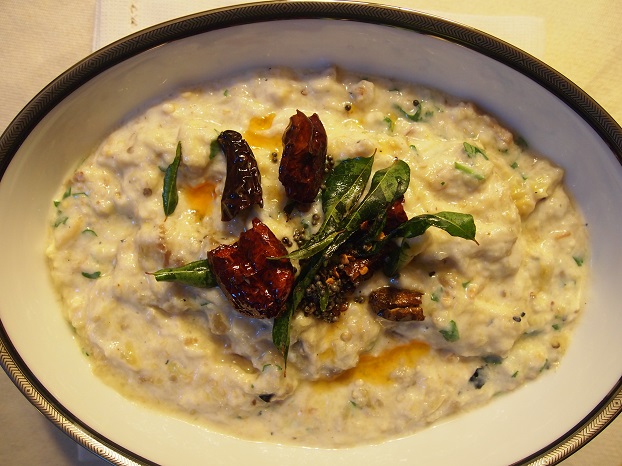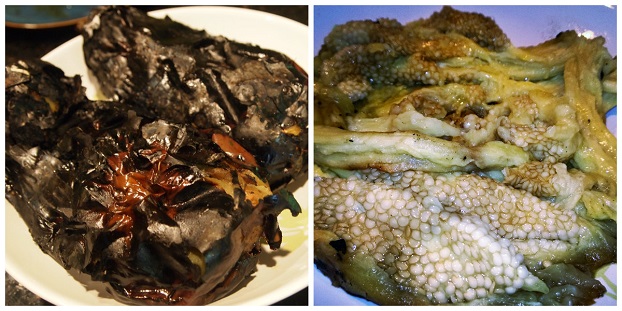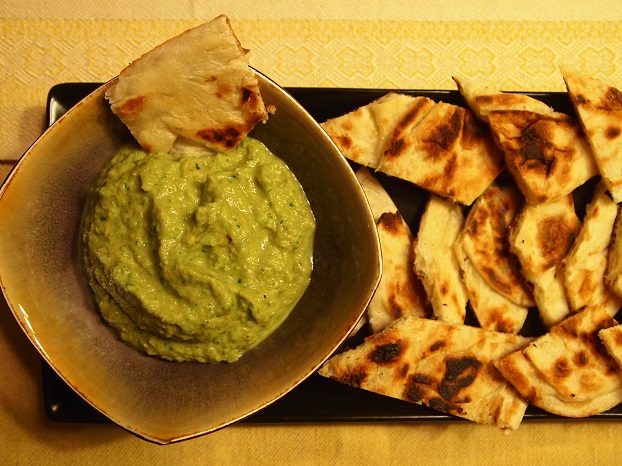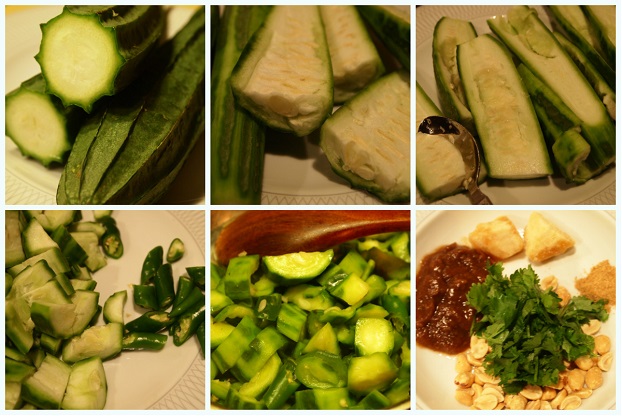The holiday party season is upon us and there’s a high probability that a fair bit of mulling over menus is transpiring at home. And if your household is anything like mine, the time between guests arriving and sitting down to the main meal is oftentimes more exciting than the meal itself. Guests tend to congregate in the kitchen when they first arrive, offering to help with finishing up preparing the main meal, chatting, catching up with old friends and getting to know new ones. It’s the patina of genial chaos that makes it all fun.
It is also this portion of the party that I find myself scratching my head over and am always casting about for ideas for appetizers and finger food that I can leave on the kitchen counter for people to help themselves to. I usually rely on a combination of cheese, olives, chips, Indian snacks (such as savory lentil mixtures, and spiced cashews and peanuts) and the ever-popular dips. Other than guacamole, which I can spice up to the heart’s content, this last category of appetizers — dips — tends to leave the taste buds wanting, tending towards the bland end of the spectrum.
Re-Purposing Bharthas and Chutneys as Delicious Dips
In my quest for dips that are a delicious departure from the ordinary, I decided to re-purpose a couple of types of condiments that play supporting roles in South Indian cooking — chutneys and bharthas. Bharthas are somewhat of an unknown quantity outside of desi circles, and while various types of chutneys are popular items on grocery store shelves, the many different South Indian cuisines boast of so many varieties that are still only found in home cooking.
Usually served with types of bread such as chapatis or rotis, bharthas are side dishes made of roasted or boiled vegetables and then mixed with plain yogurt. The cool, juicy texture of the yogurt and boiled and mashed vegetables complements the dryness of the breads. Bharthas use peanuts or sesame seeds as binding agents, bringing together the vegetables and yogurt and ensuring they blend well. Chutneys can be made out of pretty much anything, from vegetables to lentils to nuts. Most chutneys are served as condiments to dishes such as savory rice and lentil pancakes (dosas), steamed rice cakes (idlis), Indian breads such as chapatis and rotis, or rice and savory South Indian gravies such as rasam or sambhar.
Because they are perfect and very tasty with breads, chutneys and bharthas are ideal to serve as dips with thick flat breads from any cuisine — naan, pita, the Middle Eastern varieties, etc.
Once you roast your choice of bread on the pan, cut them into two-bite sized wedges so there’s enough room on each wedge to scoop up the chutney or bhartha. I’ve altered our family recipes somewhat to make them slightly thicker and easier to use as dips.
Eggplant (Brinjal) Bhartha

Makes about 2 cups. This juicy, smoky dip is an excellent foil for roasted flat bread. Let the roasted eggplant cool completely so it’s easier to handle when peeling the skin or mashing the flesh. Make it as salty and spicy as you like.
Ingredients:
2 tbsp oil
1 large black eggplant
1 cup plain reduced fat yogurt
1 dry red chili, roasted in a couple of drops of oil and snapped or crushed into tiny pieces
2 tsp sesame seed powder or peanut powder
1 tbsp chopped coriander leaves
Salt to taste (about 1 tsp)
Method:

Wash the eggplant thoroughly and wipe it clean. Dab a little oil onto your fingers and coat the eggplant with it. Roast the whole eggplant on an open flame, turning it often so the flame catches the entire surface, until it softens. This is the most important step. It requires patience. You must allow the eggplant to roast until the flesh is cooked all the way inside. It’s a good bet that it’s cooked thoroughly when the skin is burnt completely and flakes off easily and the flesh threatens to fall apart. Let it cool for about 10 minutes. Peel the skin carefully and the stem, and discard. Pull apart the flesh and make sure there’s no damage inside. Transfer the eggplant into a serving bowl and mash until smooth. Add the yogurt, chili, roasted sesame seed powder (or peanut powder), coriander leaves, and salt to the bowl and mix gently. Adjust salt as necessary.
Tempering (optional; see note 1 below):
1 tbsp oil
½ tsp mustard seeds
2 pinches asafetida
2 dry red chilies
5 curry leaves
Notes:
- Red chilies can be added while blending the eggplant with the yogurt, peanut or sesame seed powder, and the salt or as part of the tempering, which is entirely optional. Tempering is method used in South Indian cooking as a means of introducing layers of nuanced flavor to dishes. It also enhances the look of a dish. I made the use of tempering optional here because the tempering ingredients can make the dip unwieldy while trying to scoop up with a wedge of bread. If you do use tempering, try to crush the larger ingredients when they are cool enough to handle so you don’t find a big red chili or a curry leaf teetering at the edge of your bread when you scoop up the dip.
- If you can’t get your hands on dried red chilies, use ½ tsp of cayenne or Hungarian paprika or whatever kind of chili powder you have in your pantry. Note that the different kinds of chili powders have different levels of piquancy, so start with a small amount and work your way up until you reach a level that pleases your taste buds.
- The large, oval eggplant (Black Beauty) at your local grocers works wonderfully. Buy one that is smooth, firm and has no holes or other signs of damage on the skin.
- Make the sesame seed powder out of roasted sesame seeds or unsalted roasted peanuts. Crushing them to a coarse powder is better than grinding as grinding tends to make the seeds and nuts oily. When mixing the powder with the rest of the ingredients, makes sure there are no lumps in the finished dip.
Ridge Gourd (Heerekayi) Chutney

Makes about 1 ½ cups. This is a favorite among a wide swathe of my family. The jaggery, tamarind, roasted peanuts, and the roasted fenugreek powder form a surprisingly harmonious blend with the ridge gourd. The gourd itself has a pleasing, fresh aroma when roasted. If you’d like the dip spicy, go ahead and add a couple more green chilies. The balance of flavors is important, but spiciness is one aspect that could stand out.
Ingredients:
2 tsp oil
2 cups ridge gourd, peeled, seeded and diced (about two large ridge gourds)
2 green chilies (or to taste)
4 tbsp roasted, unsalted peanuts
¼ tsp fenugreek powder
2 tbsp tamarind, cleaned, seeded and strings removed
1 tbsp jaggery
Handful of cilantro leaves, stalks removed
Salt to taste

Method:
Heat the oil in a heavy based frying pan and sauté the ridge gourd and chilies for about ten minutes. You will see some of the water leaving the ridge gourd and starting to form a sauce at the bottom of the pan. Let cool. Scrape all the contents of the pan and the rest of the ingredients into a blender. Grind them into a smooth paste. Adjust seasoning, run the blender again if you add anything else. Transfer to a serving bowl.
Notes:
- Your local Indian or Pakistani grocery store is the best bet to find the ridge gourd, fenugreek seed powder (or the seeds which you can roast and powder at home), jaggery and tamarind.
- Ridge gourd is a member of the cucumber family. Look for ones that are bright green and have no signs of damage on their ridged skins. Wash them thoroughly, and with a sharp peeler, remove the ridges and as much of the skin as you can. Slice them open lengthwise, scoop out the larger of the seeds and discard them. Dice the gourd into small pieces and follow the recipe.
An interesting side note: Dried, mature ridge gourds are the source for loofahs! - Jaggery is essentially an unprocessed form of cane sugar from which the molasses have not been removed. Store unused jaggery in an airtight container. It becomes hard and very difficult to cut if exposed to air. If it does become hard, zap it in the microwave for ten seconds to make it softer. Use leftover jaggery in place of sugar. If you cannot find jaggery, you could try dark brown sugar as a substitute.
- Tamarind is the sour fruit of the tamarind tree. If you cannot find a small enough package of tamarind at the store, buy a small jar of tamarind paste but use only about a teaspoon of the paste. The flavors in the paste are more intense.
- Fenugreek seeds and the leaves of the plant are bitter. They are used extensively in Indian cooking, especially in the cuisine of North Karnataka in southern India. They are prized for their health benefits and are particularly good for lactating mothers. If you purchase fenugreek powder, store it in an airtight container. It tends to lose its aroma rather quickly. If you’re wondering what to do with leftover seeds or powder, recipes for fenugreek tea abound on the web.
So there you have it — a sweet (jaggery), spicy (chilies), sour (tamarind), bitter (fenugreek) and salty dip, scooped up onto the edge of a nicely roasted piece of bread. It’s a party in your mouth, that’s what it is.
* * *
Sujatha Bagal is a Washington, D.C.- based freelance writer and blogger. Her essays, articles and stories have appeared in various online and print publications, including Pregnancy, Mint, ForbesLife India and The Smart Set. She is working on a cookbook featuring regional Karnataka cuisine. Find her on her blog, Blogpourri, and on Twitter (@sujatha_dc).












